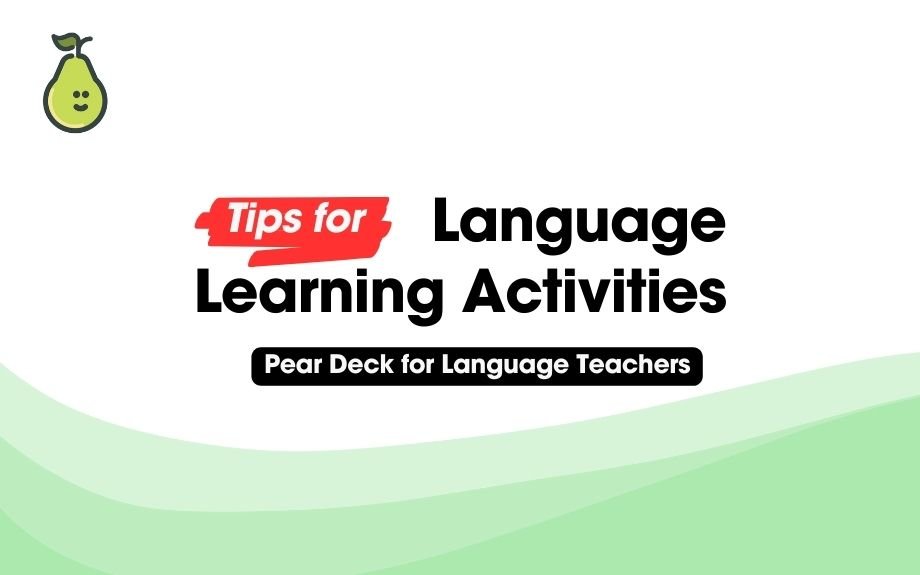In the ever-evolving landscape of education technology, where traditional classrooms are transforming into dynamic hubs of interactive learning, Pear Deck stands as a beacon for language teachers who are eager to revolutionize their teaching methods.
As our educational journey transcends traditional boundaries, the demand for innovative tools that foster engagement and empowerment has never been more evident. In response to this need, Pear Deck has emerged as a powerful ally for language teachers, providing a gateway to a new realm of interactive and immersive language learning experiences.
Practical Tips for Language Learning Activities with Pear Deck
Gone are the days of static presentations that merely delivered information to students. With Pear Deck, language teachers have the means to create presentations that invite active participation, making every lesson a collaborative effort. This blog post highlights the myriad features that make Pear Deck an indispensable asset for language teachers.
It not only highlights the capabilities of the platform, but also provides practical insights and tips on how language teachers can seamlessly integrate Pear Deck into their classrooms, increasing the impact of their language instruction. Join us on a journey through the transformative landscape of Pier Deck, where traditional language learning takes a quantum leap in the realm of engagement, interaction and meaningful student participation.
1. Vocabulary Building through Flashcards
In the pursuit of expanding on the flashcard strategy, it is crucial to consider the integration of multisensory elements. By not only incorporating images and audio but also introducing relevant smells, tastes, or tactile sensations, a more immersive learning experience can be created. This approach taps into various senses, fostering stronger neural connections and ultimately making vocabulary acquisition a more holistic process.
Active Student Engagement
- Encourage students to actively participate in the creation of their flashcards.
- Provide opportunities for them to organize vocabulary words based on personal interests or topics.
- Customizing the learning experience in this way instills a sense of ownership and responsibility for their language journey.
Transforming Review Sessions into Interactive Games
- Design engaging activities that turn flashcard review sessions into interactive games.
- Foster playful reinforcement of vocabulary through activities such as vocabulary bingo, word races, or virtual scavenger hunts.
- Adding an element of excitement to the learning process enhances retention and engagement.
Peer Teaching Sessions
- Initiate peer teaching sessions where students take turns explaining the meaning or usage of flashcard words to their classmates.
- This collaborative approach not only strengthens their understanding but also creates a supportive learning community within the classroom.
- The peer teaching model promotes a dynamic exchange of knowledge, contributing to a more comprehensive grasp of the vocabulary.
By combining these strategies, educators can create a vibrant and effective learning environment that goes beyond traditional methods, ensuring that students not only acquire vocabulary but also retain it in a meaningful and lasting way.
2. Interactive Storytelling
Expand the scope of interactive storytelling by incorporating different mediums. Combine written and spoken language with visual elements like pictures, infographics, or even short video clips. This multidimensional approach meets diverse learning preferences and stimulates creativity in language expression.
Immerse students in cultural storytelling by including stories from different areas where the target language is spoken. This not only increases language proficiency but also increases students’ cultural awareness, leading to a deeper connection with the language and its context.
Advance storytelling by creating assessment portfolios. Allow students to compile their own interactive storytelling projects, demonstrating their linguistic creativity and proficiency over time. It not only serves as a comprehensive assessment tool but also enables students to track their language development.
3. Grammar Challenges
Incorporate grammar challenges into real-life scenarios to further enforce language rules. Design interactive slides that simulate everyday situations where students must apply grammar concepts. This practical approach bridges the gap between theory and application, reinforcing the relevance of language rules.
Recognize the diverse proficiency levels in your classroom. Create adaptive grammar challenges that cater to different learning paths. Include different levels of difficulty, allowing students to choose challenges that best suit their current understanding, promoting both growth and confidence.
Empower students by allowing them to create their own grammar challenges. This not only encourages a deeper understanding of the rules of the language but also fosters a sense of responsibility for one’s own learning. Peer review sessions can be organized to share and discuss challenges posed by classmates.
4. Virtual Language Tours
Enhance the virtual language tour experience by incorporating multimedia elements. Integrate video clips, audio recordings of native speakers, and interactive maps to provide a better understanding of the language in its cultural and geographical context. This comprehensive approach broadens students’ perspectives beyond the boundaries of the traditional classroom.
Turn a virtual language tour into an ongoing exploration journal. Encourage students to document their virtual trips, noting interesting language nuances, cultural practices, and dialectal variations. It not only reinforces language learning but also promotes independent research and critical thinking.
5. Peer Collaboration and Review
Turn peer collaboration into a language game design challenge. Assign groups of students the task of creating an interactive language game using Pear Deck. These games can then be shared with the class, providing a fun way to reinforce language concepts while showcasing each group’s creativity.
Set up a virtual language café session using Pear Deck’s collaboration features. Assign different topics or language themes to small groups of students, prompting them to engage in language-rich discussions. This not only enhances language skills but also increases the sense of community and camaraderie within the classroom.
Introduce structured peer assessment protocols within collaborative activities. Provide clear guidelines for constructive feedback, encouraging students to evaluate their peers’ language use, clarity, and contribution to collaborative work. It not only promotes accountability but also enhances communication skills.
Final Words on Langauge Learning with Pear Deck
As language teachers continue to explore the extensive capabilities of Pear Deck, integrating these expanded strategies into their instructional toolkit can elevate language learning experiences to new heights.
The versatility of Pear Deck, when paired with creative and collaborative teaching methods, ensures that language education remains not only effective but also an exciting and dynamic journey for both teachers and students.
Also Read: Best Practices for Using Pear Deck in Remote Learning Environments




